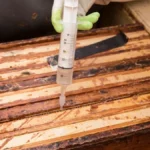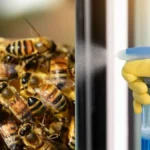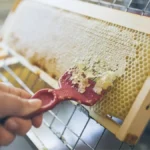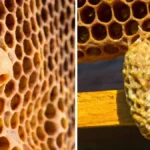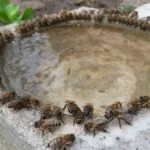The pH level of honey varies depending on the flowers the bees collect nectar from. In this article, we will take a look at the pH and acidity of different honey types, and how you can use this for health.
A Quick Overview Of pH and Acidity and What These Two Terms Mean
When we try to understand the ph level of honey and honey acidity, it is important for us to have a good understanding of what pH and acidity actually are.
pH
pH stands for potential hydrogen. Hydrogen ions make a solution acidic, hence the pH scale is a logarithmic scale of the measurement of the number of hydrogen ions in a solution. A solution with a large number of hydrogen ions in it will have a lower pH than a solution with few hydrogen ions. Solutions below a pH of 7 are increasingly acidic with pH 0 being the most acidic.
If the solution has no hydrogen ions but has hydroxide ions or similar alkaline ions, the solution will move above a pH of 7 (neutral) towards more and more alkaline, with 14 being the most alkaline.
Acidity
Superficially, many people mistake pH with acidity. This is not good. Acidity is the measure of the amount of acid in a substance. We get strong acids – they disassociate into hydrogen ions completely, and we get weak acids that do not disassociate completely.
Strong Acids
Let us zoom in on this a bit. Strong acids such as hydrochloric or sulphuric acid dissociate nearly completely in water. If we put a drop of either acid in a cup of water, it will lower the pH to a very low point. This is because all the hydrogen ions disassociated as soon as the drop hit the water. So to get a low pH we would only need a few drops of strong acid.
Weak Acids
If we look at a weak acid, such as acetic acid (vinegar) or lactic acid (sauerkraut) these acids do not release many of their hydrogen ions when they are placed in water. The result is that a drop of a weak acid will hardly lower the pH of a cup of water – you could probably have half a cup of vinegar in water and the pH will still be higher than the pH of a drop of hydrochloric acid in a cup of water. Honey tends to contain weak acids.
Titrating Acids
If we take our cup of acid that has a drop of strong acid in the water, and we put a drop of a strong base, such as caustic soda, the caustic soda will cancel out the acid and the solution will be neutral.
If we however start titrating our acetic acid solution, which has a much higher pH but a lot more acid in it, we will keep adding caustic soda, and this will neutralize some of the hydrogen ions – and then more of the acetic acid will disassociate and be ready to neutralize more caustic soda. You will end up adding a lot of caustic soda to the solution to achieve a small change in pH because there is a lot of weak acids to neutralize.
If we understand this business of weak acids, we can use that to our advantage in managing our health.
The pH Level Of Honey
I have had quite a bit of experience with discovering how completely variable this is. I make mead and work with people making mead all over the world. When we make mead, we are using yeast to convert honey sugar to alcohol – hence mead is an alcoholic honey beverage (honey wine some say).
Mead fermentations work best in a pH range of 4-5. Some honey will be way above this, and some way below.
What I have learned is that the pH of honey can range from 2.5-7.5, but the normal range is in the pH 3-5 range as is shown here. It is safe to say that most honey is acidic – ie has a pH below 7. This takes us to the next question – we know the pH of honey is normally acidic, but what is the acidity of honey?
Honey Acidity
We now have reviewed that honey can have a pH of anywhere from 2.5 to 7.5 – ranging from a low pH to slightly alkaline. However, we do not know what the acidity is – remember this is not the same as pH – acidity is the amount of acid in a unit of something.
I have found that certain honey, such as Canola, is slightly acidic – pH 4.5 in my area, and has low acidity. In other words, whatever makes it acidic, is not there in large quantities and is a relatively strong acid. Honey such as Miombo woodland honey from Zambia has a pH of about 4.3-4.5, but it seems to have a very weak acid in it. This means that this honey if you mix it with water, will be able to resist a pH change far more than Canola honey.
Generally, honey appears to be rich in weak acids, and as a result, is a good tool to use to buffer systems.
How We Can Use The pH and Acidity Of Honey To Our Advantage
Generally, the acids in honey are weak acids. Many organic systems in nature benefit from weak acids – one of these systems is your stomach. Consuming a little bit of honey containing weak acid, mixed into lemon juice, which is also a weak acid, helps your stomach.
Indigestion
Our stomach can control its pH but does this using hydrochloric acid which is a strong acid. In some cases, this strong acid can actually damage our stomachs, and for many people, consuming a weak acid will actually reduce the amount of hydrochloric acid the stomach produces. In this regard, if I have indigestion in the morning, I will drink a glass of water containing the juice of a lemon and a tablespoon of honey. This invariably cures my indigestion.
Skin Problems
Honey is an amazing skin treatment. In cases of acne and pimples, there are many people who have derived benefit out of using honey as a face pack to treat their skin. I have made a simple mixture as follows that helps for pimples and acne:
Ingredients
Purchase calcium bentonite clay. Note that this is the calcium bentonite form – you get other types, and I find that calcium bentonite works the best. You will also need coconut oil and a blender.

Manuka honey is an example of honey rich in skin-beneficial compounds.

Take a cup of hot (not boiling but close) water and place it in the blender. Run the blender. Note that when you run a blender with warm liquid this causes a rapid expansion of air and can blow the liquid all over the place.
When you start the blender, place a cloth over the lid and hold firmly. Start. Add three or four tablespoons of bentonite until the mixture takes on a consistency of mayonnaise. You can now add half a cup of honey and half a cup of coconut oil.
Cooling To Set
The mixture will take on the consistency of hair shampoo. Place it in the fridge to cool down and stir occasionally or run the blender again. As the coconut oil cools and the whole mixture solidifies you will be able to remove it and apply it to your skin as a face mask.
Specific Benefits For Darker Skin
If your skin is pink or light, any skin blemishes such as pimples leave a pink scar that fades fast. For darker skin types, these pimple scars can go very dark. This can be an especially problematic thing for young women who get a monthly pimple that leaves a scar. The use of the above face mask recipe is very effective in treating skin just before a pimple outbreak. Something in honey reduces the rate of scarring.
Honey For Burns
The first time I heard about this was when I learned about a huge hospital in a slum region of Africa. It was the largest consumer of honey in that country, using more than 30 tons a year of honey. All of this honey went to the burns unit. Poverty in the area resulted in people burning plastic for heat in winter. Children regularly fell in these fires and would receive horrific burns. The Baragwanath Hospital purchased honey and would submerge entire toddlers in honey while their skin healed – with great success. The ph level of honey and the high concentration of sugars reduce infections and encourage healing.
Times have moved on and modern science has provided more effective treatments for bad burns. For us as home healers, honey still has magic. If you place a film of honey over a mild burn and then put a bandage over this, the honey acts as a barrier to soothe and prevent scarring. I have used this to treat semi-serious burns in myself and my friends. Honey is magical, but if you have a burn it is very important to seek medical advice as soon as possible.
I hope this has helped you understand the pH level of honey, the acidity of honey, and how we can use this to heal ourselves and improve our health. If you enjoyed it, please share. And please try that face cream – guys, make it for your lady! You will be the hero of the month.
Read more about: The Best Plants For Honey Production
Honey PH Levels FAQs
What is the pH level of most honey types?
Most honey typically has a pH range between 3.0 and 5.5, making it mildly acidic.
Why does the pH level of honey vary?
The pH level of honey can vary based on the flowers bees collect nectar from and environmental factors like soil quality.
Is honey considered acidic or alkaline?
Honey is generally considered acidic, with a pH below 7. However, certain varieties can have a slightly higher, more neutral pH.
How does honey’s acidity benefit skin health?
Honey’s mild acidity can help balance skin’s pH, making it effective for treating acne and promoting wound healing.
What health conditions can benefit from honey’s acidity?
Honey’s acidity, combined with its antimicrobial properties, can aid in digestion, soothe sore throats, and promote skin health.
How does honey’s pH affect its antibacterial properties?
The acidic environment of honey inhibits the growth of bacteria, making it an effective natural antibacterial agent.
Can honey’s pH level influence its taste?
Yes, honey with a lower pH (more acidic) may taste tangier, while honey with a higher pH can taste milder.
How does honey’s pH level affect mead production?
The ideal pH for fermenting honey into mead is between 4.0 and 5.0, where yeast activity is optimized for converting sugar into alcohol.
Why is honey’s acidity important for treating burns?
Honey’s acidity, along with its high sugar content, creates a barrier that prevents infection and accelerates healing in minor burns.
How can I use honey to help with indigestion?
Consuming honey mixed with lemon juice (both weak acids) can help neutralize stomach acids and relieve indigestion.

Dr. Garth A. Cambray is a Canadian/South African entrepreneur and beekeeper with 28 years of experience in apiculture and specializes in adding value to honey. His Ph.D. research developed a new advanced continuous fermentation method for making mead that has resulted in a number of companies globally being able to access markets for mead. His company, Makana Meadery, exports honey mead to the USA where it is available to discerning connoisseurs. He has also developed technologies to commercially manufacture organic honey vinegar in Zambia for export globally. He holds a few patents globally in the ethanol industry and believes in technology and knowledge transfer for human development and environmental sustainability. One of his proudest achievements is the fact that the wind farm he started at one of his old apiary sites has essentially made his hometown carbon neutral.

